Chapter 4
Signs of a Warming Planet
Whether global warming is caused by nature, by humans, or a combination of both, there are visible changes to the planet because of it. Since the 1980s, when scientists first became concerned about global warming, they have observed shifts in weather, as well as alterations in the earth's oceans, massive ice formations, plants, and wildlife—and to some extent, all have been attributed to a planet that is becoming warmer. There is an ongoing debate among scientists about why these changes are occurring, and there is also disagreement about whether or not the changes are significant. However, the fact that they are occurring cannot be disputed because the evidence speaks for itself.
Rising Sea Waters
One result of global warming is a temperature increase in the earth's oceans, which cover nearly three-fourths of the surface of the planet. Because of their size and their dark-colored waters, oceans absorb a tremendous amount of energy from the sun. They are able to retain heat for decades or longer, which means they function as the "memory" of the earth's climate system.
Scientists at the NOAA and the Scripps Institute of Oceanography say that the world's oceans have warmed significantly over the past forty years. Temperature measurements have been taken from the surface of the water to a depth of more than nine thousand feet at sites in the Indian, Atlantic, and Pacific Oceans. From analyzing this data, NOAA scientists have concluded that the oceans have warmed at the same rate as the earth's surface temperatures. They also say that substantial temperature changes are occurring at much lower depths than they previously believed.
When oceans become warmer than normal, the water expands and becomes less dense, which causes it to spread and take up more of the planet's surface area. According to Curt Larsen, a scientist with the U.S. Geological Survey (USGS), worldwide sea levels are rising each year about twice as fast as normal. He explains how this affects one particular area, the Chesapeake Bay in Maryland, which has been the target of studies since the 1980s: "Let's say that 3 millimeters a year is an inch a decade. We are working on low-lying areas of Chesapeake Bay that have an elevation of three feet above sea level and the actual slope is very low. An inch may result in the loss of several thousand feet of marsh or lowlands. People don't think an inch a decade is very much, when in fact, it can be really significant." 21 Throughout both the Chesapeake and Delaware Bays, scientists are discovering that marshes cannot keep up with the rate of sea level rise. As a result, wetlands are becoming submerged and destroyed in those areas, as well as in other Atlantic coast states such as Florida and Georgia. Many beaches have been narrowed or completely submerged underwater as well.
Rising sea levels have affected the Atlantic coastline at Cape Hatteras, North Carolina. In 1870, when the Cape Hatteras Lighthouse was built, it stood 1,500 feet back from the shoreline. As sea waters continued to rise over the years, the coastline
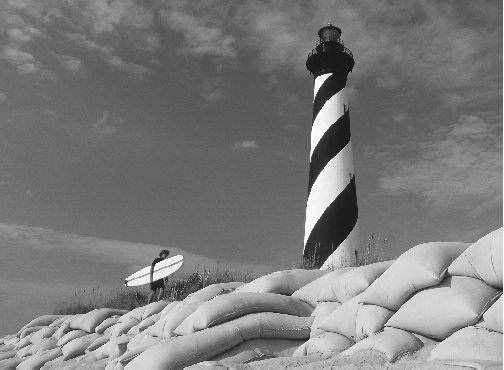
Expanding ocean waters have affected coastal areas in other parts of the world. For example, rising seas have covered or are threatening low-lying Pacific islands such as Samoa and Fiji. The tiny island nation of Majuro, which is located about halfway between Hawaii and Australia, has lost about 20 percent of its beachfront in the past ten years. The same effects are also being seen in colder parts of the world, such as Alaska, where rising Arctic Sea waters are flooding native villages and towns. In Barrow, Alaska, the northernmost city in the United States, it has become necessary for the entire population of forty-five hundred people to move because the town is gradually disappearing into the sea.
Destruction of Coral
In addition to rising sea levels, another risk of warming ocean waters is the destruction of coral reefs, which are extremely sensitive to temperature changes of any kind. The polyps that build coral reefs have clear bodies, but many tropical reefs are brilliantly colored because of algae cells, known as zooxanthellae, that live within the tissue of the coral polyps. The zooxanthellae provide the polyps with oxygen and food, and they also produce the pigment that creates the vivid reds, yellows, blues, and purples of the coral. When water temperatures become too high, the warmer water causes the polyps to expel zooxanthellae. Once the algae cells have been expelled, the white skeletons show through the
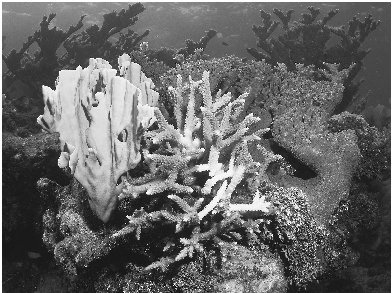
A June 1999 report by the World Wildlife Fund states that unusually high water temperatures have caused massive coral reef bleaching in recent years, most notably during 1997 and 1998. This occurred in most tropical regions, including the Pacific Ocean, Indian Ocean, Red Sea, Persian Gulf, Mediterranean Sea, and Caribbean Sea, where large numbers of coral turned completely white and died. In some parts of the Indian Ocean, more than 90 percent of the coral has been lost. All in all, an estimated 16 percent of the world's coral reefs were destroyed during 1998, and some of those species were up to seven hundred years old.
After 1999, the world's coral population continued to suffer from warmer ocean temperatures, and 2002 was the second worse year ever reported. One example of severe coral damage has occurred on Australia's Great Barrier Reef, which is considered one of the seven natural wonders of the world. Australian scientists report that coral bleaching was widespread on the Great Barrier Reef during 2002, when between 60 and 95 percent of the coral was severely damaged.
Melting Ice
Just as global warming causes ocean waters to warm, it is also causing changes in the world's ice formations. In the polar regions, huge sections of ice have thinned and broken off. One place this is happening is on the continent of Antarctica, where about 90 percent of the world's ice is found. Much of this ice is contained in ice shelves, or thick portions of ice
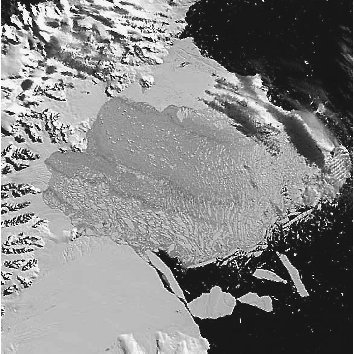
At the opposite end of the world in the Arctic Sea, the ice covering has also been shrinking. The Arctic holds the second-largest ice mass after Antarctica, and scientists studying the area say that ice sheets have been thinning for the past forty years. Using satellite measurements, scientists at the National Snow and Ice Data Center found that Arctic Sea ice in Greenland had shrunk by nearly three hundred thousand square miles—the largest decrease ever seen on the polar island.
It is not just ice sheets and glaciers in the world's coldest regions that are showing the effects of warmer global temperatures. According to the U.S. Environmental Protection Agency, the largest remaining glaciers at Glacier National Park in Montana are now only a third as large as they were in 1850. Plus, researchers have documented the rapid retreat of mountain glaciers in the Alps, the Himalayas, Ecuador, Venezuela, and New Guinea, among other areas. Since Lonnie Thompson has been exploring glaciers in the highest altitudes of the tropics, he has watched the ice continue to shrink. On Africa's Kilimanjaro, for example, there were about seven and a half square miles of ice in 1912. When Thompson photographed the ice in February 2000, he noted that the ice had shrunk to less than one and a half square miles—a loss of more than 80 percent. Plus, he has noted that ice is disappearing in Peru, another tropical area where he explores high-altitude glaciers. Peru's Quelccaya Glacier has shrunk by 20 percent since 1963, and there is now a lake that did not exist even as recently as 1974. Thompson says that in some areas, the ice is retreating at the rate of about one foot per day.
Effects on Wildlife
Crumbling ice has had a harmful effect on wildlife in regions throughout the world. Antarctica, for example, has a very large penguin population. In the past fifty years, temperatures on the Antarctic Peninsula have climbed much faster than in the rest of the world—and in that same period, the penguin population has seen a sharp decline. This was partly caused by the breakup of an enormous iceberg called the B15 in March 2000. Penguins have always been able to swim in the clear waters of the Ross Sea and hunt for krill, tiny shrimplike creatures that are their main source of food. After the iceberg split apart, massive chunks of ice blocked much of the Ross Sea. This meant the penguins had to walk, rather than swim, to and from their colonies. And since they walked more slowly than they could swim, the trip was much longer and many died of exhaustion. Female penguins that could not return to their nests were not able to feed their chicks, and so the young penguins did not survive.
Another result of the breakup of the B15 was its devastating effect on the Antarctic food chain. In the past, phytoplankton, or microscopic plants, thrived in the open water of the Ross Sea. These plants are considered the bottom of the food chain because they provide food for the krill eaten by various aquatic wildlife. Since the Ross Sea has become impeded by ice, phytoplankton has dropped by 40 percent because there is less open water where it can grow. This decrease in phytoplankton has led to a severe shortage of krill. As a result, thousands of penguins, seals, and seabirds have been unable to find food and have died of starvation.
The Arctic-dwelling polar bear is also a victim of changes in polar ice. In the Hudson Bay region of Canada, polar bears roam the ice hunting for food during the winter and early spring. During the summer when they cannot reach food, they fast. So, in the months when they are able to hunt, they must catch and eat enough to build ample amounts of fat on their bodies to sustain them during their fasting period. Over the past twenty years, warmer temperatures have caused Hudson Bay ice to break up three or four weeks earlier in the spring, which means the bears have less time to hunt. As a result, they have less food to hold them over for the winter so they lose weight—and when that happens, they are in grave danger of starving to death. Zoologist Ian Stirling has studied the Hudson Bay's polar bears for nearly twenty years, and he explains why the warming climate is having such an effect on them: "Some people have asked me why wouldn't they walk further north. The reason is there's already bears there. The other reason is that these bears grew up here, they know this area. They are committed to being here and if the ice just gets less and less and less . . . if the climate keeps on warming, ultimately there won't be polar bears in this part of the world." 23
Vanishing Permafrost
When the climate warms enough in cold areas to cause ice to melt, permafrost—permanently frozen rock and soil—is also affected. Permafrost is located
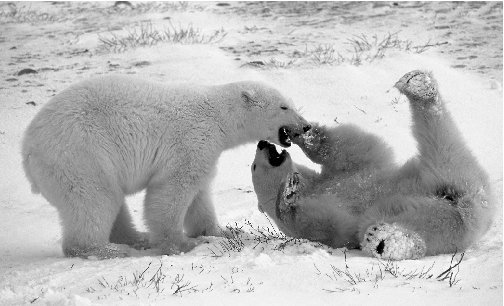
In Alaska—where temperatures have risen as much as seven degrees higher than normal—nearly the entire state has been hard-hit because of thawing permafrost. In cities and towns all over the state, melting permafrost is causing the ground to shift and become increasingly unstable as it develops holes, pits, and trenches. As a result, homes and other buildings are damaged or destroyed, roads become as bumpy as roller coasters, and airport runways and railroad tracks have buckled. In the summer of 2002 a sinkhole, or collapsed section of land, developed along a highway, and a hundred feet of earth was suddenly flushed away. According to George Levasseur, who works for the Alaska Department of Transportation, forty-five miles of highway had to be rebuilt in hundreds of different locations, and the repairs cost more than $4 million. He describes the magnitude of the problem: "The whole Alaska Highway from Northway to the border is coming apart. It's just exploding." 24 The shifting earth causes erosion and landslides, as well as the collapse of large sections of forestland—which kills trees and all other vegetation growing there. The moving land causes silt and gravel to be dumped into rivers and creeks, which creates floods and damages bridges.
In the Alaskan coastal village of Kipnuk, most structures show signs that the ground beneath them
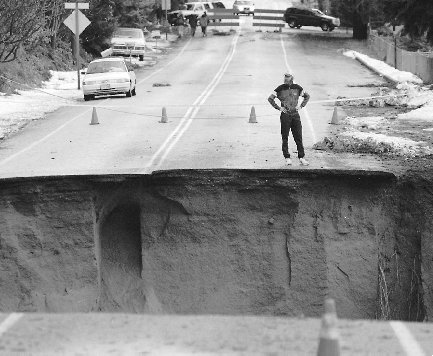
Across the Alaskan border in the Yukon Territory of northwestern Canada, melting permafrost is causing serious problems for the Inuvialuit, a native people whose ancestors settled on Herschel Island many generations ago. Because the earth is no longer frozen, coffins, long buried in the island's graveyards, are working their way to the surface, as one writer explains: "Graves are pushing up from the ground as the ice within the carpet of permafrost melts, churning the soil beneath it into a muddy soup, spitting up foreign contents, sending whole hill slopes sliding downward. On a far tip of this island an entire grave site one day got up and slipped into the sea." 26
Violent Weather
Warmer climates can also influence the weather. Scientists cannot say for sure that global warming causes extreme weather, but they do know that weather at its hottest typically breeds the most severe storms. Powerful thunderstorms, hurricanes, and tornadoes are naturally created when warm air rises and collides with extremely cold air high in the atmosphere. The hotter the air, the faster it rises, and the stronger its clash with the cold air. So, the storms that are created are much more fierce.
The intensity of storms is also affected by the warming ocean waters. As the earth becomes warmer, the ocean heats up, causing storms such as cyclones and hurricanes to be especially severe. Science historian and author Angela Eiss explains this: "The problem . . . is that the higher the overall temperature, the greater the intensity of all cyclones. . . . [T]he temperature sets the maximum intensity a storm can reach. . . . So, if you increase the temperature, you increase the intensities of all tropical storms—just as a rising tide raises all the boats." 27
Hurricanes, a particularly violent kind of storm, are only formed over oceans because they draw their energy from warm tropical waters, normally above eighty-one degrees Fahrenheit. The World Wildlife Fund explains how this is connected to a warmer climate: "Once this temperature is reached, so much water evaporates from the sea surface that, as it condenses, sufficient energy is released to create a 'vortex' around which the hurricane forms. Every degree above that temperature produces an exponential increase in the [potential] for storms." 28 After a hurricane develops, it gathers heat and energy through contact with warm ocean waters. As the ocean continues to contribute more moisture to the storm, the hurricane becomes as powerful as a gigantic heat engine, with winds of more than 155 miles per hour.
Hurricanes can last for days or even weeks, and they usually cover thousands of miles of land before they die out. Between 1995 and 1998, there were thirty-three hurricanes reported—an all-time record. In 1998, the hottest year on record, there were four Atlantic hurricanes in progress at one time. Scientists say that in a hundred years of observations, that had never occurred before. In the fall of that same year, the deadliest Atlantic hurricane in more than two hundred years—Hurricane Mitch—struck Central America. Before it had run its course, the hurricane had killed more than eleven hundred people, left millions of others homeless, and caused billions of dollars in damage. In Nicaragua, Hurricane Mitch caused mudslides that buried whole villages; and in Honduras, raging floods caused by the storm swept away bridges and devastated crops.
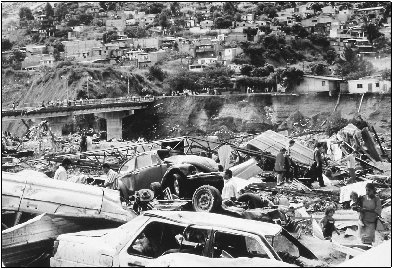
What Is Next?
Even though scientists agree that the earth is showing the effects of a warming climate, they do not agree about what that means now, or what it could mean in the future. Robert B. Gagosian says it is crucial for scientists to learn everything they can about global warming. He explains:
In just the past year, we have seen ominous signs that we may be headed toward a potentially dangerous threshold. If we cross it, Earth's climate could switch gears and jump very rapidly—not gradually—into a completely different mode of operation. This is not something new under the Sun. It has happened throughout Earth's history, and it could happen again. . . . As a society, I believe we must face the potential for abrupt climate change. Perhaps we can mitigate the changes. If not, at least we can still take steps to adapt to them. . . . In other words, the more knowledge we have—the more reliably we can predict changes—the better our chances. Maybe over the edge of the cliff, there's just a three-inch drop-off. Or maybe there's a big, fluffy bed full of pillows. My worry is that we are indeed approaching this cliff blindfolded. 29
"In the Alaskan coastal village of Kipnuk, most structures show signs that the ground beneath them"
It abruptly stops.
Thanks for reading.